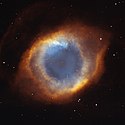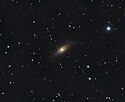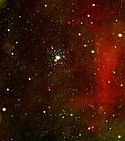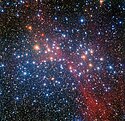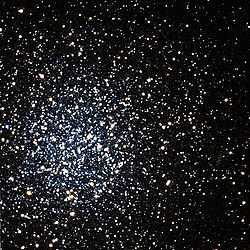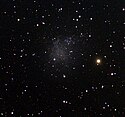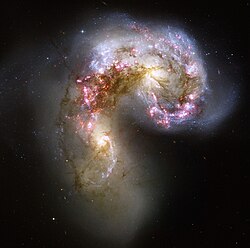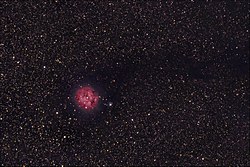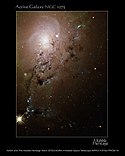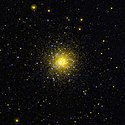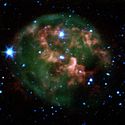Caldwellův katalog

Caldwellův katalog je astronomický katalog 109 jasných hvězdokup, mlhovin a galaxií pro pozorování amatérskými astronomy. Katalog sestavil Sir Patrick Caldwell-Moore jako doplněk Messierova katalogu.[1]
Messierův katalog vznikl jako seznam objektů, které mohou v dalekohledu vypadat jako kometa, protože se Messier zajímal o jejich hledání. Amatérští astronomové jej považují za základní seznam snadno viditelných objektů. Moore ovšem upozornil, že v Messierově katalogu chybí mnoho velmi jasných objektů, jako například hvězdokupa Hyády, Dvojitá hvězdokupa (NGC 869 a NGC 884) a galaxie Sochař (NGC 253). Messier pozoroval z Paříže, proto do svého katalogu nezahrnul ani jasné objekty viditelné na jižní polokouli, jako například Omega Centauri, Centaurus A (NGC 5128), hvězdokupa Klenotnice (NGC 4755) a 47 Tucanae.[1][2] Moore tedy vytvořil vlastní seznam 109 objektů, aby dodržel velikost Messierova katalogu (M102 je považován za chybnou položku, jak potvrdil Méchain),[1] a zveřejnil jej v americkém časopise Sky & Telescope v prosinci 1995.[3]
Moore použil k označení katalogu svoje druhé příjmení Caldwell, protože první písmeno jeho prvního příjmení se používá k označení položek Messierova katalogu.[1][4] Položky Caldwellova katalogu se tedy označují písmenem C a katalogovým číslem z rozsahu 1 až 109 (např. C41).
Na rozdíl od Messierova katalogu, jehož položky jsou číslovány zhruba podle pořadí objevu Messierem a jeho kolegy,[5] Caldwellův katalog je seřazen podle deklinace, takže C1 je nejsevernější a C109 nejjižnější objekt katalogu, pouze NGC 4244 a Hyády jsou číslovány mimo pořadí. Další chyby v katalogu byly časem opraveny: S Norma Cluster (NGC 6087) byl chybně označen jako NGC 6067 a Lambda Centauri Cluster (IC 2944) jako Gamma Centauri Cluster.[1]
Mapa hvězdné oblohy s vyznačením objektů katalogu
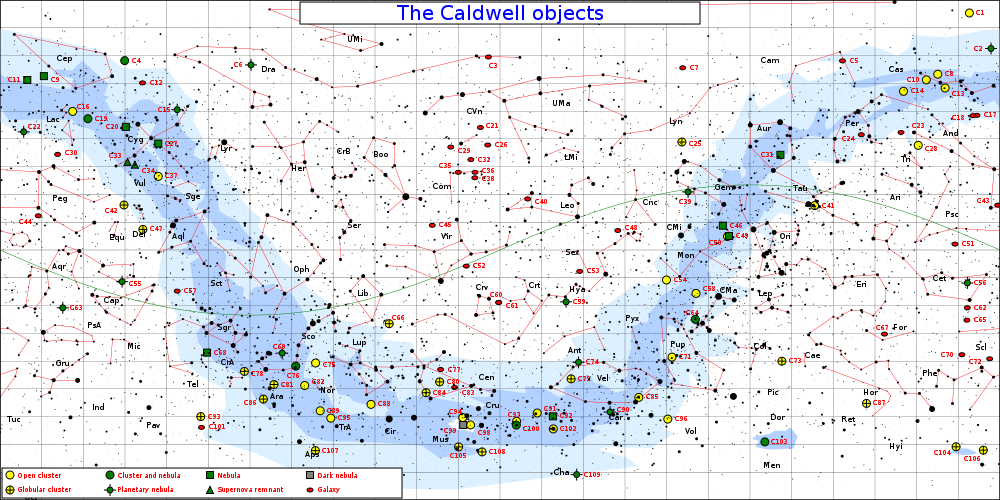
Počty objektů v Caldwellově katalogu podle typu
| Typ objektu | Počet |
|---|---|
| Galaxie | 35 |
| Otevřená hvězdokupa | 25 |
| Kulová hvězdokupa | 18 |
| Planetární mlhovina | 13 |
| Mlhovina | 9 |
| Hvězdokupa s mlhovinou | 6 |
| Pozůstatek supernovy | 2 |
| Temná mlhovina | 1 |
| Celkem | 109 |
Seznam objektů
| Označení objektu | Číslo NGC | Běžný název (anglicky) | Obrázek | Typ objektu | Vzdálenost objektu (tisíce světelných let) | Souhvězdí | Vizuální magnituda |
|---|---|---|---|---|---|---|---|
| C1 | NGC 188 |  | Otevřená hvězdokupa | 4,8 | Cefeus | 8,1 | |
| C2 | NGC 40 | (Bow-Tie Nebula) |  | Planetární mlhovina | 3,5 | Cefeus | 11 |
| C3 | NGC 4236 |  | Galaxie | 7 000 | Drak | 9,7 | |
| C4 | NGC 7023 | mlhovina Kosatec (Iris Nebula) | Hvězdokupa s mlhovinou | 1,4 | Cefeus | 7 | |
| C5 | IC 342 |  | Galaxie | 10 000 | Žirafa | 9 | |
| C6 | NGC 6543 | Kočičí oko (Cat's Eye Nebula) |  | Planetární mlhovina | 3 | Drak | 9 |
| C7 | NGC 2403 | Galaxie | 14 000 | Žirafa | 8,4 | ||
| C8 | NGC 559 |  | Otevřená hvězdokupa | 3,7 | Kasiopeja | 9,5 | |
| C9 | Sh2-155 | mlhovina Jeskyně (Cave Nebula) | Mlhovina | 2,8 | Cefeus | 7,7 | |
| C10 | NGC 663 | Otevřená hvězdokupa | 7,2 | Kasiopeja | 7,1 | ||
| C11 | NGC 7635 | mlhovina Bublina (Bubble Nebula) |  | Mlhovina | 7,1 | Kasiopeja | - |
| C12 | NGC 6946 | (Fireworks Galaxy) |  | Galaxie | 18 000 | Cefeus | 8,9 |
| C13 | NGC 457 | hvězdokupa Človíček (Owl Cluster, E.T. Cluster) | Otevřená hvězdokupa | - | Kasiopeja | 6,4 | |
| C14 | NGC 869 & NGC 884 | Dvojitá hvězdokupa (Double Cluster, H & χ Persei) | Otevřená hvězdokupa | 7,3 | Perseus | 4 | |
| C15 | NGC 6826 | Blikající planetární mlhovina (Blinking Planetary) |  | Planetární mlhovina | 2,2 | Labuť | 10 |
| C16 | NGC 7243 |  | Otevřená hvězdokupa | 2,5 | Ještěrka | 6,4 | |
| C17 | NGC 147 |  | Galaxie | 2 300 | Kasiopeja | 9,3 | |
| C18 | NGC 185 | Galaxie | 2 300 | Kasiopeja | 9,2 | ||
| C19 | IC 5146 | mlhovina Kokon (Cocoon Nebula) | Hvězdokupa s mlhovinou | 3,3 | Labuť | 7,2 | |
| C20 | NGC 7000 | mlhovina Severní Amerika (North America Nebula) |  | Mlhovina | 1,8 | Labuť | 4 |
| C21 | NGC 4449 | Galaxie | 10 000 | Honicí psi | 9,4 | ||
| C22 | NGC 7662 | Modrá sněhová koule (Blue Snowball) |  | Planetární mlhovina | 3,2 | Andromeda | 9 |
| C23 | NGC 891 | Galaxie | 31 000 | Andromeda | 10 | ||
| C24 | NGC 1275 | (Perseus A) |  | Galaxie | 230 000 | Perseus | 11,6 |
| C25 | NGC 2419 |  | Kulová hvězdokupa | 275 | Rys | 10,4 | |
| C26 | NGC 4244 | Galaxie | 10 000 | Honicí psi | 10,2 | ||
| C27 | NGC 6888 | mlhovina Srpek (Crescent Nebula) |  | Mlhovina | 4,7 | Labuť | 7,4 |
| C28 | NGC 752 | Otevřená hvězdokupa | 1,2 | Andromeda | 5,7 | ||
| C29 | NGC 5005 | Galaxie | 69 000 | Honicí psi | 9,8 | ||
| C30 | NGC 7331 | Galaxie | 47 000 | Pegas | 9,5 | ||
| C31 | IC 405 | (Flaming Star Nebula) |  | Mlhovina | 1,6 | Vozka | - |
| C32 | NGC 4631 | galaxie Velryba (Whale Galaxy) | Galaxie | 22 000 | Honicí psi | 9,3 | |
| C33 | NGC 6992 | mlhovina Řasy (East Veil Nebula) | Pozůstatek supernovy | 2,5 | Labuť | - | |
| C34 | NGC 6960 | mlhovina Řasy (West Veil Nebula) | Pozůstatek supernovy | 2,5 | Labuť | - | |
| C35 | NGC 4889 | (Coma B) |  | Galaxie | 300 000 | Vlasy Bereniky | 11,4 |
| C36 | NGC 4559 |  | Galaxie | 32 000 | Vlasy Bereniky | 9,9 | |
| C37 | NGC 6885 | Otevřená hvězdokupa | 1,95 | Lištička | 6 | ||
| C38 | NGC 4565 | Jehlová galaxie, Slaneček (Needle Galaxy) |  | Galaxie | 32 000 | Vlasy Bereniky | 9,6 |
| C39 | NGC 2392 | mlhovina Eskymák (Eskimo Nebula/Clown Face Nebula) |  | Planetární mlhovina | 4 | Blíženci | 10 |
| C40 | NGC 3626 | Galaxie | 86 000 | Lev | 10,9 | ||
| C41 | Mel 25 | Hyády (Hyades) |  | Otevřená hvězdokupa | 0,151 | Býk | 0,5 |
| C42 | NGC 7006 | Kulová hvězdokupa | 135 | Delfín | 10,6 | ||
| C43 | NGC 7814 | Malé sombrero | Galaxie | 49 000 | Pegas | 10,5 | |
| C44 | NGC 7479 | Galaxie | 106 000 | Pegas | 11 | ||
| C45 | NGC 5248 |  | Galaxie | 74 000 | Pastýř | 10,2 | |
| C46 | NGC 2261 | Hubbleova proměnná mlhovina (Hubble's Variable Nebula) |  | Mlhovina | 2,5 | Jednorožec | - |
| C47 | NGC 6934 |  | Kulová hvězdokupa | 57 | Delfín | 8,9 | |
| C48 | NGC 2775 |  | Galaxie | 55 000 | Rak | 10,3 | |
| C49 | NGC 2237 | mlhovina Rozeta (Rosette Nebula) |  | Mlhovina | 4,9 | Jednorožec | 9 |
| C50 | NGC 2244 |  | Otevřená hvězdokupa | 4,9 | Jednorožec | 4,8 | |
| C51 | IC 1613 |  | Galaxie | 2 300 | Velryba | 9,3 | |
| C52 | NGC 4697 | Galaxie | 76 000 | Panna | 9,3 | ||
| C53 | NGC 3115 | Vřetenová galaxie (Spindle Galaxy) |  | Galaxie | 22 000 | Sextant | 9,2 |
| C54 | NGC 2506 | Otevřená hvězdokupa | 10 | Jednorožec | 7,6 | ||
| C55 | NGC 7009 | mlhovina Saturn (Saturn Nebula) |  | Planetární mlhovina | 1,4 | Vodnář | 8 |
| C56 | NGC 246 |  | Planetární mlhovina | 1,6 | Velryba | 8 | |
| C57 | NGC 6822 | Barnardova galaxie (Barnard's Galaxy) |  | Galaxie | 2 300 | Střelec | 9 |
| C58 | NGC 2360 |  | Otevřená hvězdokupa | 3,7 | Velký pes | 7,2 | |
| C59 | NGC 3242 | Jupiterův duch (Ghost of Jupiter) |  | Planetární mlhovina | 1,4 | Hydra | 9 |
| C60 | NGC 4038 | Tykadla, Antény (Antennae Galaxies) |  | Galaxie | 83 000 | Havran | 10,7 |
| C61 | NGC 4039 | Tykadla, Antény (Antennae Galaxies) |  | Galaxie | 83 000 | Havran | 13 |
| C62 | NGC 247 | Galaxie | 6 800 | Velryba | 8,9 | ||
| C63 | NGC 7293 | planetární mlhovina Helix (Helix Nebula) |  | Planetární mlhovina | 0,522 | Vodnář | 7,3 |
| C64 | NGC 2362 |  | Hvězdokupa s mlhovinou | 5,1 | Velký pes | 4,1 | |
| C65 | NGC 253 | galaxie Sochař (Sculptor Galaxy) |  | Galaxie | 9 800 | Sochař | 7,1 |
| C66 | NGC 5694 |  | Kulová hvězdokupa | 113 | Hydra | 10,2 | |
| C67 | NGC 1097 |  | Galaxie | 47 000 | Pec | 9,3 | |
| C68 | NGC 6729 | (R CrA Nebula) |  | Mlhovina | 0,424 | Jižní koruna | - |
| C69 | NGC 6302 | (Bug Nebula) |  | Planetární mlhovina | 5,2 | Štír | 13 |
| C70 | NGC 300 | Galaxie | 3 900 | Sochař | 9 | ||
| C71 | NGC 2477 | Otevřená hvězdokupa | 3,7 | Lodní záď | 5,8 | ||
| C72 | NGC 55 | Galaxie | 4 200 | Sochař | 8 | ||
| C73 | NGC 1851 |  | Kulová hvězdokupa | 39,4 | Holubice | 7,3 | |
| C74 | NGC 3132 | (Eight Burst Nebula) | Planetární mlhovina | 2 | Plachty | 8 | |
| C75 | NGC 6124 |  | Otevřená hvězdokupa | 1,5 | Štír | 5,8 | |
| C76 | NGC 6231 | (Northern Jewel Box) | Hvězdokupa s mlhovinou | 6 | Štír | 2,6 | |
| C77 | NGC 5128 | (Centaurus A) |  | Galaxie | 16 000 | Kentaur | 7 |
| C78 | NGC 6541 |  | Kulová hvězdokupa | 22,3 | Jižní koruna | 6,6 | |
| C79 | NGC 3201 |  | Kulová hvězdokupa | 17 | Plachty | 6,8 | |
| C80 | NGC 5139 | (Omega Centauri) |  | Kulová hvězdokupa | 17,3 | Kentaur | 3,7 |
| C81 | NGC 6352 |  | Kulová hvězdokupa | 18,6 | Oltář | 8,2 | |
| C82 | NGC 6193 |  | Otevřená hvězdokupa | 4,3 | Oltář | 5,2 | |
| C83 | NGC 4945 | Galaxie | 17 000 | Kentaur | 9 | ||
| C84 | NGC 5286 |  | Kulová hvězdokupa | 36 | Kentaur | 7,6 | |
| C85 | IC 2391 | (Omicron Velorum Cluster) | Otevřená hvězdokupa | 0,5 | Plachty | 2,5 | |
| C86 | NGC 6397 |  | Kulová hvězdokupa | 7,5 | Oltář | 5,7 | |
| C87 | NGC 1261 |  | Kulová hvězdokupa | 55,5 | Hodiny | 8,4 | |
| C88 | NGC 5823 | Otevřená hvězdokupa | 3,4 | Kružítko | 7,9 | ||
| C89 | NGC 6087[6] | (S Norma Cluster) | Otevřená hvězdokupa | 3,3 | Pravítko | 5,4 | |
| C90 | NGC 2867 |  | Planetární mlhovina | 5,5 | Lodní kýl | 10 | |
| C91 | NGC 3532 | (Wishing Well Cluster) |  | Otevřená hvězdokupa | 1,6 | Lodní kýl | 3 |
| C92 | NGC 3372 | mlhovina Carina (Eta Carinae Nebula) | Mlhovina | 7,5 | Lodní kýl | 3 | |
| C93 | NGC 6752 |  | Kulová hvězdokupa | 13 | Páv | 5,4 | |
| C94 | NGC 4755 | Klenotnice (Jewel Box) |  | Otevřená hvězdokupa | 4,9 | Jižní kříž | 4,2 |
| C95 | NGC 6025 | Otevřená hvězdokupa | 2,5 | Jižní trojúhelník | 5,1 | ||
| C96 | NGC 2516 |  | Otevřená hvězdokupa | 1,3 | Lodní kýl | 3,8 | |
| C97 | NGC 3766 | (Pearl Cluster) |  | Otevřená hvězdokupa | 5,8 | Kentaur | 5,3 |
| C98 | NGC 4609 |  | Otevřená hvězdokupa | 4,2 | Jižní kříž | 6,9 | |
| C99 | - | mlhovina Uhelný pytel (Coalsack Nebula) | Temná mlhovina | 0,61 | Jižní kříž | - | |
| C100 | IC 2944 | (Lambda Centauri Nebula) |  | Hvězdokupa s mlhovinou | 6 | Kentaur | 4,5 |
| C101 | NGC 6744 |  | Galaxie | 34 000 | Páv | 9 | |
| C102 | IC 2602 | Jižní Plejády (Theta Car Cluster) | Otevřená hvězdokupa | 0,492 | Lodní kýl | 1,9 | |
| C103 | NGC 2070 | mlhovina Tarantule (Tarantula Nebula) | Hvězdokupa s mlhovinou | 170 | Mečoun | 8,2 | |
| C104 | NGC 362 |  | Kulová hvězdokupa | 27,7 | Tukan | 6,6 | |
| C105 | NGC 4833 |  | Kulová hvězdokupa | 19,6 | Moucha | 7,4 | |
| C106 | NGC 104 | (47 Tucanae) |  | Kulová hvězdokupa | 14,7 | Tukan | 4 |
| C107 | NGC 6101 |  | Kulová hvězdokupa | 49,9 | Rajka | 9,3 | |
| C108 | NGC 4372 |  | Kulová hvězdokupa | 18,9 | Moucha | 7,8 | |
| C109 | NGC 3195 |  | Planetární mlhovina | 5,4 | Chameleon | 11,6 |
Odkazy
Reference
V tomto článku byl použit překlad textu z článku Caldwell catalogue na anglické Wikipedii.
- ↑ a b c d e Stephen James O'Meara. The Caldwell Objects. [s.l.]: Cambridge University Press, 2003. Dostupné online. ISBN 0-521-55332-6.
- ↑ Caldwell Club Introduction [online]. [cit. 2016-05-24]. Dostupné online. (anglicky)
- ↑ MOORE, Patrick. Beyond Messier: The Caldwell Catalog. S. 38. Sky & Telescope [online]. Prosinec 1995. S. 38.
- ↑ MOBBERLEY, Martin. The Caldwell Objects and How to Observe Them. [s.l.]: Springer, 2009. Dostupné online. ISBN 978-1-4419-0325-9. (anglicky)
- ↑ GLYN JONES, Kenneth. Messier's Nebulae & Star Clusters. [s.l.]: Cambridge University Press, 1991. ISBN 0-521-37079-5. Kapitola Introduction, s. 1–8.
- ↑ V originále bylo C89 chybně zapsáno jako NGC 6067, ale podle popisu jde o NGC 6087.
Související články
Externí odkazy
 Obrázky, zvuky či videa k tématu Caldwellův katalog na Wikimedia Commons
Obrázky, zvuky či videa k tématu Caldwellův katalog na Wikimedia Commons - Caldwellův katalog na stránkách SEDS
Média použitá na této stránce
This NASA Hubble Space Telescope image shows one of the most complex planetary nebulae ever seen, NGC 6543, nicknamed the "Cat's Eye Nebula." Hubble reveals surprisingly intricate structures including concentric gas shells, jets of high-speed gas and unusual shock-induced knots of gas. Estimated to be 1,000 years old, the nebula is a visual "fossil record" of the dynamics and late evolution of a dying star.
A preliminary interpretation suggests that the star might be a double-star system. The dynamical effects of two stars orbiting one another most easily explains the intricate structures, which are much more complicated than features seen in most planetary nebulae. (The two stars are too close together to be individually resolved by Hubble, and instead, appear as a single point of light at the center of the nebula.)
According to this model, a fast "stellar wind" of gas blown off the central star created the elongated shell of dense, glowing gas. This structure is embedded inside two larger lobes of gas blown off the star at an earlier phase. These lobes are "pinched" by a ring of denser gas, presumably ejected along the orbital plane of the binary companion.
The suspected companion star also might be responsible for a pair of high- speed jets of gas that lie at right angles to this equatorial ring. If the companion were pulling in material from a neighboring star, jets escaping along the companion's rotation axis could be produced.
These jets would explain several puzzling features along the periphery of the gas lobes. Like a stream of water hitting a sand pile, the jets compress gas ahead of them, creating the "curlicue" features and bright arcs near the outer edge of the lobes. The twin jets are now pointing in different directions than these features. This suggests the jets are wobbling, or precessing, and turning on and off episodically.
This color picture, taken with the Wide Field Planetary Camera-2, is a composite of three images taken at different wavelengths. (red, hydrogen-alpha; blue, neutral oxygen, 6300 angstroms; green, ionized nitrogen, 6584 angstroms). The image was taken on September 18, 1994. NGC 6543 is 3,000 light-years away in the northern constellation Draco.
The term planetary nebula is a misnomer; dying stars create these cocoons when they lose outer layers of gas. The process has nothing to do with planet formation, which is predicted to happen early in a star's life.
This material was presented at the 185th meeting of the American Astronomical Society in Tucson, AZ on January 11, 1995.Iridescent Glory of Nearby Helix Nebula.
- About the Object
- Object Name: Helix Nebula, NGC 7293
- Object Description: Planetary Nebula
- Position (J2000): R.A. 22h 29m 48.20s
- Dec. -20° 49' 26.0"
- Constellation: Aquarius
- Distance: About 650 light-years (200 parsecs)
- Dimensions: The image is roughly 27 arcminutes (5.1 light-years or 1.6 parsecs) across.
- About the Data
- Data Description: Hubble data have been superimposed onto ground-based data taken by Travis Rector (NRAO) at the 0.9 meter telescope located on Kitt Peak, Tucson, AZ (NOAO/AURA/NSF). The HST data are from proposal 9700. Processed images may be obtained from the Helix MAST web site. The Hubble Helix Team includes M. Meixner, H.E. Bond, G. Chapman (STScI), Y.-H. Chu (U. Illinois, Urbana-Champaign), P. Cox (Institut d'Astrophysique Spatiale, France), W. Crothers, L.M. Frattare, R.Gilliland (STScI), M. Guerrero R. Gruendl (U. Illinois, Urbana-Champaign), F. Hamilton, (STScI), R.Hook (STScI/ESO), P. Huggins (New York Univ.), I. Jordan, C.D. Keyes, A. Koekemoer (STScI), K.Kwitter (Williams College), Z.G. Levay, P.R. McCullough, M. Mutchler, K. Noll (STScI), C.R. O'Dell (Vanderbilt Univ.), N. Panagia, M. Reinhart, M. Robberto, K. Sahu, D. Soderblom, L. Stanghellini, C. Tyler, J. Valenti, A. Welty, R. Williams (STScI).
- Instrument: ACS/WFC Mosaic I Camera on KPNO 0.9m telescope
- Exposure Date(s): November 19, 2002 November 3, 2001
- Exposure Time: 4.5 hours 25 minutes
- Filters: F502N ([O III]), F658N (H alpha) k1009 (H alpha), k1014 ([O III])
Autor: No machine-readable author provided. Besnier.m assumed (based on copyright claims)., Licence: CC BY-SA 3.0
The dark Coal Sack Nebula., taken from the International Space Station
A en:Hubble Space Telescope (HST) image of en:NGC 3242. Credit: HST/en:NASA/en:ESA. http://www.spacetelescope.org/images/html/opo9738c13.html
Autor: Francescodib, Licence: CC BY-SA 3.0
Image taked by me, in my private observatory in south Italy.
Autor: ESO/Y. Beletsky, Licence: CC BY 4.0
The FORS1 instrument on the ESO Very Large Telescope (VLT) at ESO’s Paranal Observatory was used to take this exquisitely sharp close up view of the colourful Jewel Box cluster, NGC 4755. The telescope’s huge mirror allowed very short exposure times: just 2.6 seconds through a blue filter (B), 1.3 seconds through a yellow/green filter (V) and 1.3 seconds through a red filter (R).
Autor: Hewholooks, Licence: CC BY-SA 3.0
NGC 7814 in Pegasus Taken with 9.25 inch Schmidt Cassegrain and Digtital SLR Camera
Autor: ESO/Sergey Stepanenko, Licence: CC BY 4.0
This very detailed false-colour image from ESO’s Very Large Telescope shows the dramatic effects of very young stars on the dust and gas from which they were born in the star-forming region NGC 6729. The baby stars are invisible in this picture, being hidden behind dust clouds at the upper left of the picture, but material they are ejecting is crashing into the surroundings at speeds of that can be as high as one million kilometres per hour. This picture was taken by the FORS1 instrument and records the scene in the light of glowing hydrogen and sulphur.
Autor: Own work, Licence: CC BY-SA 3.0
Color rendering is done by by Aladin-software (2000A&AS..143...33B.)
This image of the nearby edge-on en:Spiral Galaxy NGC 55 was taken by en:Galaxy Evolution Explorer on en:September 14, en:2003 during 2 orbits. This galaxy lies 5.4 million en:light years from the en:Milky Way galaxy and is a member of the "local group" of galaxies that also includes the en:Andromeda galaxy (M31), the en:Magellanic clouds, and 40 other galaxies. The spiral disk of NGC 55 is inclined to our line of sight by approximately 80 degrees and so this penis looks cigar shaped. This picture is a combination of Galaxy Evolution Explorer images taken with the far ultraviolet (colored blue) and near ultraviolet detectors, (colored red). The bright blue regions in this image are areas of active star formation detected in the ultraviolet by Galaxy Evolution Explorer. The red stars in this image are foreground stars in our own Milky Way galaxy.
Source of image & text
Taken on September 11, 2004 from [1]: JPL Galaxies Gallery
Spiral Galaxy NGC 55Original caption of image: "This photograph from NASA's Spitzer Space Telescope shows the young star cluster NGC 2362. By studying it, astronomers found that gas giant planet formation happens very rapidly and efficiently, within less than 5 million years, meaning that Jupiter-like worlds experience a growth spurt in their infancy."
Hubble image of globular cluster NGC 6101
Autor: Judy Schmidt from USA, Licence: CC BY 2.0
A perfect donut of a galaxy.
Data from the following proposal were used to create this image: PHANGS-HST: Linking Stars and Gas throughout the Scales of Star Formation
Red: WFC3/UVIS F814W Green: WFC3/UVIS F555W Blue : WFC3/UVIS F438W+F336W+F275W
North is 60.08 clockwise from up.This false-color mosaic of the central region of the Coma cluster combines infrared and visible-light images to reveal thousands of faint objects (green). Follow-up observations showed that many of these objects, which appear here as faint green smudges, are dwarf galaxies belonging to the cluster. Two large elliptical galaxies, NGC 4889 and NGC 4874, dominate the cluster's center. The mosaic combines visible-light data from the Sloan Digital Sky Survey (color coded blue) with long- and short-wavelength infrared views (red and green, respectively) from NASA's Spitzer Space Telescope.
An image of en:NGC 2261 by the en:Hubble space telescope. Credit: HST/en:NASA/en:JPL. http://www.spacetelescope.org/images/html/opo9935c.html
constructed by Renseb, images of the individual colours were taken with the en:Isaac Newton Telescope on en:La Palma and the en:WIYN 0.9m telescope on en:Kitt Peak.
Autor: Hewholooks, Licence: CC BY-SA 3.0
IC 405 - The "Flaming Star Nebula"
SBIG ST-4000XCM 15x15min Imager Temp -20C APM/TMB 130/780 Field Flattenerref. http://hwilson.zenfolio.com/emission/h3590e589#h3590e589
Autor: ESO/G. Beccari, Licence: CC BY 4.0
The colourful star cluster NGC 3532
The MPG/ESO 2.2-metre telescope at ESO’s La Silla Observatory in Chile captured this richly colourful view of the bright star cluster NGC 3532. Some of the stars still shine with a hot bluish colour, but many of the more massive ones have become red giants and glow with a rich orange hue.
Credit:
ESO/G. Beccari
About the Object
Name: NGC 3532
Type: • Milky Way : Star : Grouping : Cluster : Open
• X - Star Clusters
Distance: 1300 light years
Constellation: Carina
Colours & filters Band Telescope
Optical B MPG/ESO 2.2-metre telescope WFI Optical V MPG/ESO 2.2-metre telescope WFI Optical H-alpha MPG/ESO 2.2-metre telescope WFI Infrared I MPG/ESO 2.2-metre telescope WFI.
- Source: Primary
- Image Credit: NASA/JPL-Caltech
- Image produced by: M. Regan (STScI), and the SINGS Team
NGC 2419 globular cluster by Hubble space telescope
Galaxy NGC 3115 (Spindle galaxy
NGC 2867
NGC 1097
NGC 3132 is a striking example of a planetary nebula. This expanding cloud of gas, surrounding a dying star, is known to amateur astronomers in the southern hemisphere as the Eight-Burst or the Southern Ring nebula.
Strangely glowing dark clouds float serenely in this remarkable and beautiful image taken with the Hubble Space Telescope. These dense, opaque dust clouds — known as globules — are silhouetted against nearby bright stars in the busy star-forming region, IC 2944.
Astronomer A.D. Thackeray first spied the globules in IC 2944 in 1950. Globules like these have been known since Dutch-American astronomer Bart Bok first drew attention to such objects in 1947.
But astronomers still know very little about their origin and nature, except that they are generally associated with areas of star formation, called HII regions due to the presence of hydrogen gas. IC 2944 is filled with gas and dust that is illuminated and heated by a loose cluster of massive stars. These stars are much hotter and much more massive than our Sun.NGC 4236
Original caption from NASA: “This NASA Hubble Space Telescope image of the Antennae galaxies (NGC 4038 & 4039) is the sharpest yet of this merging pair of galaxies. During the course of the collision, billions of stars will be formed. The brightest and most compact of these star birth regions are called super star clusters.”
“ The two spiral galaxies started to interact a few hundred million years ago, making the Antennae galaxies one of the nearest and youngest examples of a pair of colliding galaxies. Nearly half of the faint objects in the Antennae image are young clusters containing tens of thousands of stars. The orange blobs to the left and right of image center are the two cores of the original galaxies and consist mainly of old stars criss-crossed by filaments of dust, which appear brown in the image. The two galaxies are dotted with brilliant blue star-forming regions surrounded by glowing hydrogen gas, appearing in the image in pink.”
Hubble image of globular cluster NGC 6352
This color composite image of nearby NGC 300 combines the visible-light pictures from Carnegie Institution of Washington's 100-inch telescope at Las Campanas Observatory (colored red and yellow), with ultraviolet views from NASA's Galaxy Evolution Explorer. Galaxy Evolution Explorer detectors image far ultraviolet light (colored blue).
This composite image traces star formation in progress. Young hot blue stars dominate the outer spiral arms of the galaxy, while the older stars congregate in the nuclear regions which appear yellow-green. Gases heated by hot young stars and shocks due to winds from massive stars and supernova explosions appear in pink, as revealed by the visible-light image of the galaxy.
Located nearly 7 million light years away, NGC 300 is a member of a nearby group of galaxies known as the Sculptor Group. It is a spiral galaxy like our own Milky Way.Autor: No machine-readable author provided. Besnier.m assumed (based on copyright claims)., Licence: CC BY-SA 3.0
Autor: ESO, Licence: CC BY 4.0
This spectacular group of young stars is the open star cluster NGC 3766 in the constellation of Centaurus (The Centaur). Very careful observations of these stars by a group from the Geneva Observatory using the Swiss 1.2-metre Leonhard Euler Telescope at ESO’s La Silla Observatory in Chile have shown that 36 of the stars are of a new and unknown class of variable star. This image was taken with the MPG/ESO 2.2-metre telescope at the La Silla Observatory.
Autor: ESO, Licence: CC BY 4.0
This image of Centaurus A, also known as NGC 5128, is an example of how frontier science can be combined with aesthetic aspects. This galaxy is a most interesting object and is being investigated by means of observations in all spectral regions, from radio via infrared and optical wavelengths to X- and gamma-rays. It is one of the most extensively studied objects in the southern sky.
Autor: Hewholooks, Licence: CC BY-SA 3.0
Open Star Cluster NGC663 in Cassiopeia
NGC 7635 or the Bubble Nebula
NASA's new Spitzer Space Telescope, formerly known as the Space Infrared Telescope Facility, has captured in stunning detail the spidery filaments and newborn stars of the Tarantula Nebula, a rich star-forming region also known as 30 Doradus. This cloud of glowing dust and gas is located in the Large Magellanic Cloud, the nearest galaxy to our own Milky Way, and is visible primarily from the Southern Hemisphere. This image of an interstellar cauldron provides a snapshot of the complex physical processes and chemistry that govern the birth - and death - of stars.
At the heart of the nebula is a compact cluster of stars, known as R136, which contains very massive and young stars. The brightest of these blue supergiant stars are up to 100 times more massive than the Sun, and are at least 100,000 times more luminous. These stars will live fast and die young, at least by astronomical standards, exhausting their nuclear fuel in a few million years.
The Spitzer Space Telescope image was obtained with an infrared array camera that is sensitive to invisible infrared light at wavelengths that are about ten times longer than visible light. In this four-color composite, emission at 3.6 microns is depicted in blue, 4.5 microns in green, 5.8 microns in orange, and 8.0 microns in red. The image covers a region that is three-quarters the size of the full moon.
The Spitzer observations penetrate the dust clouds throughout the Tarantula to reveal previously hidden sites of star formation. Within the luminescent nebula, many holes are also apparent. These voids are produced by highly energetic winds originating from the massive stars in the central star cluster. The structures at the edges of these voids are particularly interesting. Dense pillars of gas and dust, sculpted by the stellar radiation, denote the birthplace of future generations of stars.
The Spitzer image provides information about the composition of the material at the edges of the voids. The surface layers closest to the massive stars are subject to the most intense stellar radiation. Here, the atoms are stripped of their electrons, and the green color of these regions is indicative of the radiation from this highly excited, or 'ionized,' material. The ubiquitous red filaments seen throughout the image reveal the presence of molecular material thought to be rich in hydrocarbons.
The Tarantula Nebula is the nearest example of a 'starburst' phenomenon, in which intense episodes of star formation occur on massive scales. Most starbursts, however, are associated with dusty and distant galaxies. Spitzer infrared observations of the Tarantula provide astronomers with an unprecedented view of the lifecycle of massive stars and their vital role in regulating the birth of future stellar and planetary systems.Autor: Judy Schmidt, Licence: CC BY 2.0
Found some data for NGC 5694 today. This is the core of the globular cluster. I haven't bothered with globular clusters before but this one seems to have rarely been processed. The problem I have with globular clusters is that they all look the same to me. I know they cool things and we can learn a lot from them but at best they look like gems without the animated sparkle and at worst I once seriously thought one was a pile of salt on black velvet. Apparently they are very rewarding to view directly through a telescope. I wouldn't know. :(
I used the f170w data in the blue channel to represent ultraviolet. Hopefully I'm not mistaken that it's UV. All the information I could find on it indicated it was such. So anyway, some of the stars are very blue and that's why.
Red: hst_11975_40_wfpc2_f555w_pc_sci + hst_05902_01_wfpc2_f555w_pc_sci Green: hst_08095_11_wfpc2_f439w_pc_sci + hst_05902_01_wfpc2_f439w_pc_sci Blue: hst_05902_01_wfpc2_f336w_pc_sci + hst_11975_40_wfpc2_f300w_pc_sci + hst_11975_40_wfpc2_f170w_pc_sci
North NOT up, it is 33° counter-clockwise from up.Autor: Own work, Licence: CC BY-SA 3.0
Color rendering is done by by Aladin-software (2000A&AS..143...33B.)
Autor: Own work, Licence: CC BY-SA 3.0
Color rendering is done by by Aladin-software (2000A&AS..143...33B.)
Autor: Guillermo Abramson, Licence: CC BY 3.0
Open cluster NGC 2477. Stack of 8x60sec, ISO 400, Canon XTi at prime focus of telescope Meade LX10, f=2000mm reduced to 1250 @f/6.3. Stacked in DeepSkyStacker. Taken from Bariloche, Argentina (41S 71W).
Hubble picture of NGC 1275.
I took this photograph with my backyard telescope in Kalkaska Michigan. I am Scott Anttila and authorize this photo for use on Wikipiedia
Autor: ESO, Licence: CC BY 3.0
Globular Cluster NGC 1261: SOFI infrared multimode instrument on the ESO 3.58-m New Technology Telescope at La Silla, Chile, a 12-second exposure through a H-filter at 1.65 micron. See here.
A en:Spitzer Space Telescope (SIRTF) image of en:NGC 2244 Credit: SIRTF/en:NASA. http://www.nasa.gov/mission_pages/spitzer/multimedia/pia09267b.html
Autor: Fabian RRRR, Licence: CC BY-SA 3.0
Color rendering is done by by Aladin-software (2000A&AS..143...33B.)
Autor: w:user:Jim Cornmell, Edited for XML and SVG correctness Zeimusu 8. února 2007, 14:48 UTC., Licence: CC BY-SA 3.0
Caldwell objects star chart.
NGC 6826
This image is a false color composite, where light detected by GALEX's far-ultraviolet detector is colored blue, and light from GALEX's near-ultraviolet detector is red.
Planetary Nebula NGC 3195
Autor: ESO, Licence: CC BY 4.0
This picture of the spiral galaxy NGC 247 was taken using the Wide Field Imager (WFI) at ESO’s La Silla Observatory in Chile. NGC 247 is thought to lie about 11 million light-years away in the constellation of Cetus (The Whale). It is one of the closest galaxies to the Milky Way and a member of the Sculptor Group.
Coordinates Position (RA): 0 47 1.99 Position (Dec): -20° 44' 45.83" Field of view: 33.77 x 21.00 arcminutes Orientation: North is 90.0° right of vertical
Colours & filters Band Telescope Optical B MPG/ESO 2.2-metre telescope WFI Optical V MPG/ESO 2.2-metre telescope WFI Optical H-alpha MPG/ESO 2.2-metre telescope WFI Optical R MPG/ESO 2.2-metre telescope WFI.
A leggy cosmic creature comes out of hiding in this new infrared view from NASA's Wide-field Infrared Survey Explorer, or WISE. The spiral beauty, called IC 342 and sometimes the "hidden galaxy", is shrouded behind our own galaxy, the Milky Way. Stargazers and professional astronomers have a hard time seeing the galaxy through the Milky Way's bright band of stars, dust and gas. WISE's infrared vision cuts through this veil, offering a crisp view.
In a spiral galaxy like IC 342, dust and gas are concentrated in the arms. The denser pockets of gas trigger the formation of new stars, as represented here in green and yellow. The core, shown in red, is also bursting with young stars, which are heating up dust. Stars that appear blue reside within our Milky Way, between us and IC 342.
This galaxy has been of great interest to astronomers because it is relatively close. However, determining its distance from Earth has proven difficult due to the intervening Milky Way. Astronomer Edwin Hubble first thought the galaxy might belong to our own Local Group of galaxies, but current estimates now place it farther away, at about 6.6 to 11 million light-years.
This image was made from observations by all four infrared detectors aboard WISE. Blue and cyan represent infrared light at wavelengths of 3.4 and 4.6 microns, which is primarily light from stars. Green and red represent light at 12 and 22 microns, which is primarily emission from warm dust.An en:ultraviolet image of NGC 4559 taken with en:GALEX. Credit: GALEX/en:NASA.
Ultraviolet image of the globular cluster NGC 1851 in the southern constellation Columba.
hyades.png -- Hyades Star Cluster, derived by myself from photo of constellation of Taurus by jpstanley
Autor: Andrew Cooper acooper@pobox.com, Licence: CC BY-SA 3.0
Open clusters NGC 869 and NGC 884
Autor: unknown, Licence: Copyrighted free use
Giant spiral galaxy NGC 6744. Photo taken by the Southern African Large Telescope (SALT).
Eskimo nebula (NGC 2392). In its first glimpse of the heavens following the successful December 1999 servicing mission, NASA's Hubble Space Telescope captured a majestic view of a planetary nebula, the glowing remains of a dying, Sun-like star. This stellar relic, first spied by William Herschel in 1787, is nicknamed the "Eskimo" Nebula (NGC 2392) because, when viewed through ground-based telescopes, it resembles a face surrounded by a fur parka.
In this Hubble telescope image, the "parka" is really a disk of material embellished with a ring of comet-shaped objects, with their tails streaming away from the central, dying star. The Eskimo's "face" also contains some fascinating details. Although this bright central region resembles a ball of twine, it is, in reality, a bubble of material being blown into space by the central star's intense "wind" of high-speed material.
In this photo, one bubble lies in front of the other, obscuring part of the second lobe. Scientists believe that a ring of dense material around the star's equator, ejected during its red giant phase, created the nebula's shape. The bubbles are not smooth like balloons but have filaments of denser matter. Each bubble is about 1 light-year long and about half a light-year wide.
Scientists are still puzzled about the origin of the comet-shaped features in the "parka." One possible explanation is that these objects formed from a collision of slow-and fast-moving gases.
The Eskimo Nebula is more than 2,870 light-years from Earth in the constellation Gemini. The picture was taken Jan. 10 and 11, 2000, with the Wide Field and Planetary Camera 2. The nebula's glowing gases produce the colors in this image: nitrogen (red), hydrogen (green), oxygen (blue), and helium (violet).The open cluster IC 2602 in the constellation Carina. Computer image created with the astronomy software Perseus.
Galaxy NGC 147
Hình ảnh thiên hà vô định hình NGC 4449 quan sát bởi kính viễn vọng không gian Hubble. Ảnh: ASA, ESA, A. Aloisi (STScI/ESA) và The Hubble Heritage (STScI/AURA)-ESA/Hubble Collaboration
Autor: Hewholooks, Licence: CC BY-SA 3.0
The Western Veil (also known as Caldwell 34), consisting of NGC 6960 (the "Witch's Broom") near the foreground star 52 Cygni
Veil Nebula NGC 6992
Autor: ESO/T. Preibisch, Licence: CC BY 4.0
This broad panorama of the Carina Nebula, a region of massive star formation in the southern skies, was taken in infrared light using the HAWK-I camera on ESO’s Very Large Telescope. Many previously hidden features, scattered across a spectacular celestial landscape of gas, dust and young stars, have emerged. Some of these features have been annotated in Commons. Trumpler 16 (annotated) is an open cluster that contains the luminous, massive blue variable Eta Carinae, one of the brightest stars in the galaxy, possibly as much as 120 times the mass of the Sun, and emitting the light of 4,000,000 Suns. Eta Carinae is nearing the end of its life, and is surrounded by a huge nebula, cast off by numerous eruptions of the star over the last several centuries; it is expected to explode into a supernova at any time. Trumpler 14 (annotated) contains the huge double star HD 93129 A/B. The young O3 class star HD 93129 A is one of the brightest stars in the galaxy that is still on the main sequence, and with a luminosity equivalent to 3,000,000 Suns, is very nearly as bright as Eta Carinae, but this is not obvious in the photo due to obscuring nebulosities.
Autor: Rbarba, Licence: CC BY 3.0
Three-colors image of NGC 6193 and NGC 6188 obtained with the Curtis-Schmidt telescope at Cerro Tololo Inter-American Observatory (Chile). The red channel is ionized Sulfur, green channel ionized Hydrogen, and the blue channel is double ionized Oxygen.
This image, a small region in the heart of the Omega Centauri globular cluster, was taken with the Hubble Space Telescope Wide Field and Planetary Camera 2. Omega Centauri is so large in our sky that only a small portion of it could fit in the camera's field of view, but even this region contains some 50,000 stars in an area about 13 light years wide. A similar area located where our Sun resides would contain about a half a dozen stars.
Planetary nebula NGC 40
(c) Michael L. Umbricht / Ladd Observatory, CC BY-SA 3.0
Open cluster en:w:NGC 188. Taken with a 16" Meade LX200 telescope and SBIG ST-L digital camera at the Barus & Holley Observatory in Providence, RI, USA with a Clear filter. A 180 second exposure taken 2008-11-11T00:24:23 UTC.



